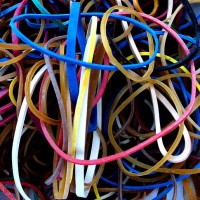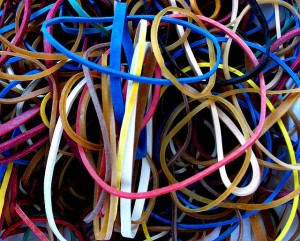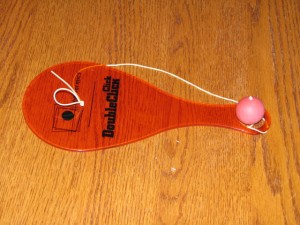

Photo by eek the cat
I can hear you saying it to yourself from here, “What in blazes is the Rubber Band Hypothesis?” Well I’m glad you asked.
The rubber band hypothesis is a new twist on the old nature/nurture debate. It’s an analogy that helps explain the relationship between talent and training in determining an athlete’s performance level, from novice through expert.
Let me explain, a rubber bands come in certain sizes and with certain elastic properties. It can be big enough to hold a rolled up newspaper or small, like those teeny tiny ones the orthodontist puts on your braces (my teeth hurt just thinking about them).
You can have rubber bands that barely stretch a millimeter (like those strange ones that hold the broccoli stocks together in the produce section). And, you can have the super stretchy kind of elastic like those used for paddle ball (the one man game that looks like so much fun, until you play it).
Just like an athlete’s genes, once set, these properties can’t be changed. The rubber band will only stretch as far as it’s size and elasticity will allow it. This is it’s potential stretch.

Photo by Dan Perry
Now, what determines how far the rubber band actually stretches is the work put into it. This is the training.
If you consider the length the rubber band stretches as its performance, smaller, less elastic rubber bands can be stretched as far or farther than bigger, more elastic rubber bands if more work is done on the former compared to the latter.
The athlete, like the rubber band, has a genetic potential. However, this potential is immutable. It can’t be changed. What can be changed though, is how much work is put into reaching the athlete’s potential. The stretching of the rubber band. This is where you can expend your energy and make positive changes.
Rubber bands in Dog Sports
The rubber band hypothesis can be viewed from two different perspectives in dog sports. First, you have the handler who has a level of athletic potential and trains to get the most out of their performances. Second, you have the dog who, of course, has genetic potential but needs training to stretch towards its best performances.
Now I want you to spend a couple of seconds to think about how we see the rubber bands in our four-legged companions and in ourselves. When we are choosing our next flyball or agility dog, do we give equal weight to the dogs genetic potential and it’s ability to train or do we favour one over the other? How do we attribute our performances? Are we just born to perform at this level or can we do something about it?
Big questions I know. Something to think about on a cool, fall afternoon. I’d like to hear your thoughts. Please share in the comments.
Leave A Reply (8 comments so far)
The comments are closed.
Bonnie
14 years ago
In the past 4 years I have choose 3 agility puppies. The first puppy I wanted brave and play drive, I picked the puppy that played the hardest but also went out to explore. I got crazy border collie that took 4 years to train, now a awesome dog. 2nd puppy I wanted something that had lots of play, brave was also high on my list but I didn’t pick the puppy that explored the furthest I took the puppy that stayed close and interacted with me. I got crazy border collie that doesnt’ like to move to far away but we can train that. He is working into a great dog. 3rd puppy now 5mths old is high but not too high likes to work with me but is always thinking. This might be my best dog yet, either I am a better dog trainer or I finally got it right, time will tell. I have lots of rubber to stretch in my 3 awesome dogs I think drive is important if you have drive you can work the genetic rubber of any dog. My class mates and I where discussing it tonight people just don’t train enough. Every successfull athelete trains more then they compete especially when they are learning the game. People very often get what they put in.
Lynn Cuthbert
14 years ago
I am currently working with my sheltie that I bought as a pet, who spent most of puppy class under the chairs. He was shy and soft. I have worked with him in flyball and in agility and he has become phenomenal in agility and consistent at flyball. He is not fast at flyball and has to “check out” the box judge as he passes, but he is fast at agility and does very very well at Masters. I do have an excellent coach and we do work hard, but do not overtrain. I have learned more from this dog than I can tell you. I think our success is a combination of hard work, patience and relationship. I did not give up on this dog, and I believe I have learned more from him than I would have had he been easy. My second sheltie was bought “for agility” and of course a pet, and yes his training is easier. I think I am better at it too. He is a blast to work with, but I will never underestimate my first guy and never stop working with him until he retires. Genetics is something, but not everything!!!
BJ Walker
14 years ago
I have a very high drive three year old bearded collie who goes over the top very easily. The more we train and trial, the worse she has become. We did foundation work for the 1st 2 years of her life before beginning to compete. I chose her from a litter I bred, because she wasn’t the one who ran off to explore, but stayed close. She also taught herself to sit and wait for treats, and was very easy to teach to play tug. A thinking dog from the beginning!
After 3 years of not being permissive and using only positive reinforcement, I’m at my wits end and have gone into the Land of No (Susan Garrett term). I’m not happy about this, but really don’t know what else to do.
Genetics? Since I know the line very well, I can see where this behavior comes from. Training? I have been as consistent as I know how, am calm on the course, but sassy barking and fly offs on the contacts are becoming more and more prevalent.
I suppose everyone has periods of frustration, but with all the foundation work that I’ve done with this little girl, I expected better results by now. Is this all she can do? More training? Big questions indeed.
Julie Rice
14 years ago
What I don’t understand about your analogy is this: You state: “If you consider the length the rubber band stretches as its performance, smaller, less elastic rubber bands can be stretched as far or farther than bigger, more elastic rubber bands if more work is done on the former compared to the latter.” I don’t see how you can stretch one of those tiny elastics as far as a long, loose elastic no matter how much work you put into it. If you keep stretching the small one trying to get it to passs the longer one, it will break.
John Cullen
14 years ago
I agree that if you stretch an elastic beyond what it’s capable of, it will break. And in the case of an athlete, the genes do limit what maximum level an athlete can reach. This is only in the situation when they are performing at 100% of their potential. I would argue that with very few exceptions (maybe none), full potential is never reached. What an athlete may lack in talent can be made up and surpassed with in training. Their are lots of athletes with great talent (potential), but many don’t train hard enough to come close to their potential.
jane newman-ralph
14 years ago
It is important to understand the conformation needed for a dog to be successful at any given sport. Also important is the dog’s ability to focus and to love work.
When choosing my next companion I must understand my own shortcomings [how far my rubber band will stretch] For myself and at my age it will be important that to develop into a well oiled team my dog must have drive, able to work at a distance, take direction, and have confidence in my handling. A dog with drive who wants to stick to my side will only be frustrating and cause the dog to doubt my leadership.
We must complement each other. So I must be able to understand my dogs needs, be able to train to maintain my dogs abilty to work at a distance, to be clear in my directions, confident in my handling and have the drive to develop all the skills needed to be successful. Most important I must take responsiblity for our mistakes and look outside the box for ways to stretch both rubber bands to correct those mistakes so we can both enjoy riding the edge.
Jane
Claire Pavia
14 years ago
Very often it’s the same breeds (or individual dogs) with the best genetic potential wich are also the best trainable…like Border Collies, Belgian Shepherds and Aussies.
I would personally have trainability as my priority though.
Claire Pavia
14 years ago
After 3 years of foundation and training in Agility, if the result is frustrating, I guess Susan Garrett would say that dog is giving feedback…maybe the answer is not train more, but train differently.
Maybe put the dog on a break, or change to a sport wich suits the dog better…just some thoughts.
About the rubber band who is training and trialing with my dog, I don’t think my genetics are good for sports, I can’t run fast…so I try to compensate by being smart…using distance and directional cues…not there yet but improving !